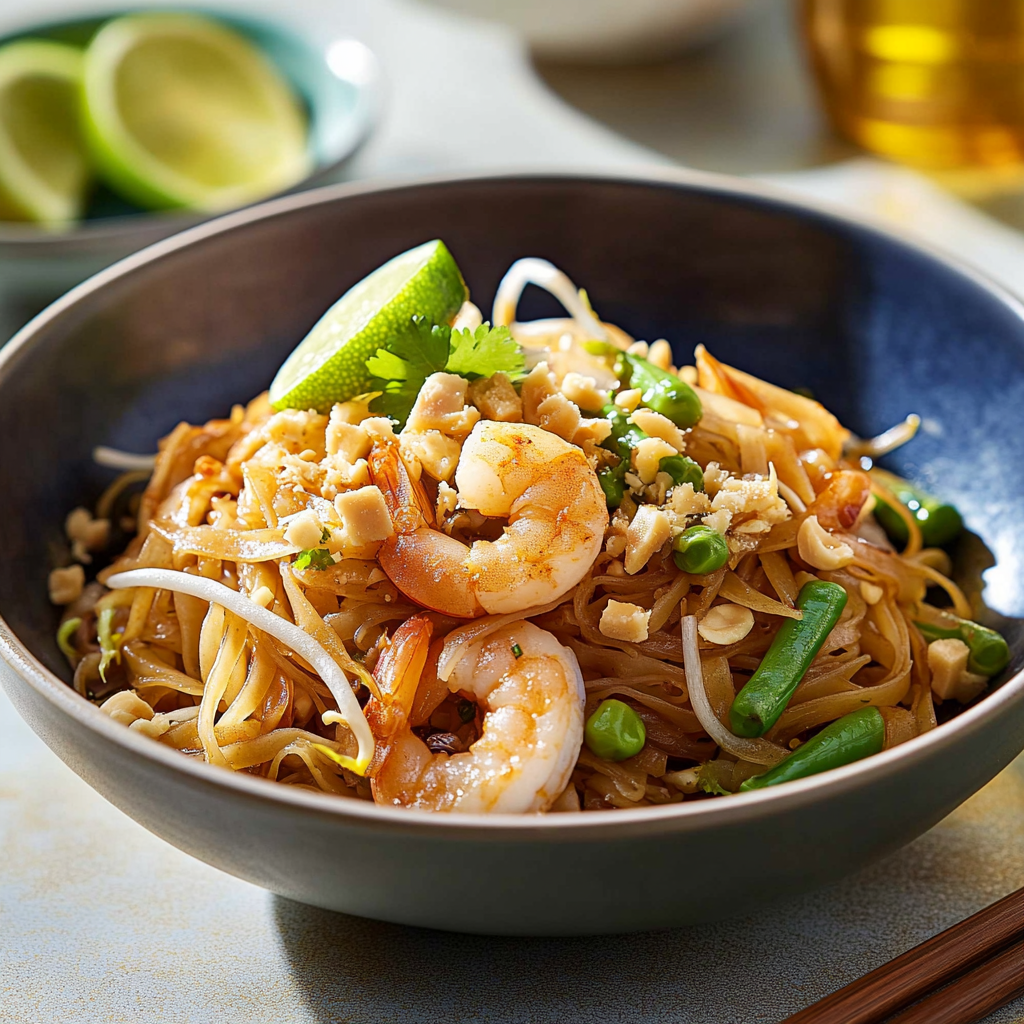Have you ever craved the perfect balance of sweet, salty, and tangy flavors all in one dish? Enter Pad Thai—a delightful stir-fried noodle dish that fills your senses with its vibrant colors and enticing aroma. From the first bite, you’ll experience the harmony of textures as you savor the chewy rice noodles combined with crunchy peanuts and fresh vegetables.
Pad Thai is not just a meal; it’s an experience that brings people together. Whether you’re serving it at a casual dinner party or enjoying it on a cozy night in, this dish is always a hit. Imagine the sizzling sound of the ingredients hitting the pan as they cook to perfection. You’ll look forward to every forkful of this flavorful dish, making it an ideal choice for any occasion.
Why You’ll Love This Pad Thai
- Quick and Easy: This Pad Thai recipe can be prepared in under 30 minutes, making it perfect for busy weeknights or last-minute gatherings.
- Customizable Ingredients: You can easily substitute proteins or add more vegetables to suit your taste preferences or dietary needs.
- Authentic Flavor: With a perfect blend of sweet tamarind paste and savory soy sauce, you’ll enjoy an authentic taste that rivals restaurant quality.
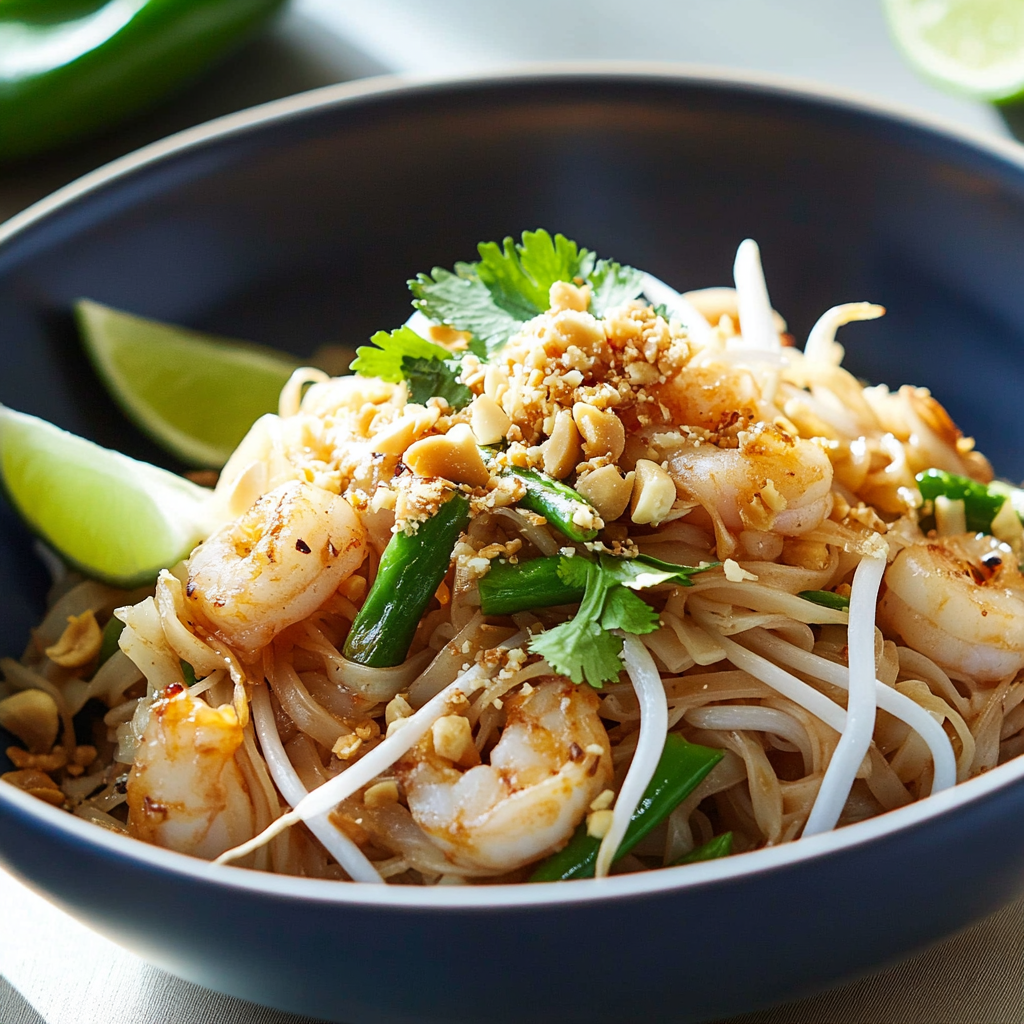
Ingredients for Pad Thai
Here’s what you’ll need to make this delicious dish:
- Rice Noodles: Use flat rice noodles for an authentic texture; soak them in warm water beforehand for easier cooking.
- Tofu or Chicken: Choose firm tofu for a vegetarian option or boneless chicken for added protein; either can be marinated for extra flavor.
- Eggs: Fresh eggs add richness to the dish; scramble them directly into the pan during cooking.
For the Sauce:
- Tamarind Paste: This ingredient gives Pad Thai its signature tangy flavor; look for it in Asian grocery stores or online.
- Soy Sauce: Opt for low-sodium soy sauce to control saltiness while enhancing umami flavor.
- Brown Sugar: The sweetness from brown sugar balances out the tanginess from tamarind; feel free to adjust based on your taste preference.
The full ingredients list, including measurements, is provided in the recipe card directly below.
How to Make Pad Thai
Follow these simple steps to prepare this delicious dish:
Step 1: Prepare Your Ingredients
Gather all your ingredients and chop your vegetables into bite-sized pieces. Soak rice noodles in warm water for about 20 minutes until softened.
Step 2: Make the Sauce
In a bowl, mix together tamarind paste, soy sauce, and brown sugar until well combined. Set aside.
Step 3: Cook Proteins
Heat oil in a large skillet over medium-high heat. Add cubed tofu or sliced chicken and cook until golden brown. Remove from pan and set aside.
Step 4: Stir-Fry Vegetables
In the same skillet, add garlic and any vegetables like bell peppers or bean sprouts. Stir-fry for about two minutes until tender-crisp.
Step 5: Combine Ingredients
Add soaked rice noodles to the skillet along with cooked proteins. Pour sauce over everything and toss gently to combine.
Step 6: Scramble Eggs
Create space in the pan by pushing ingredients aside. Crack eggs into that space and scramble quickly before mixing everything together.
Transfer to plates and drizzle with additional sauce if desired for the perfect finishing touch.
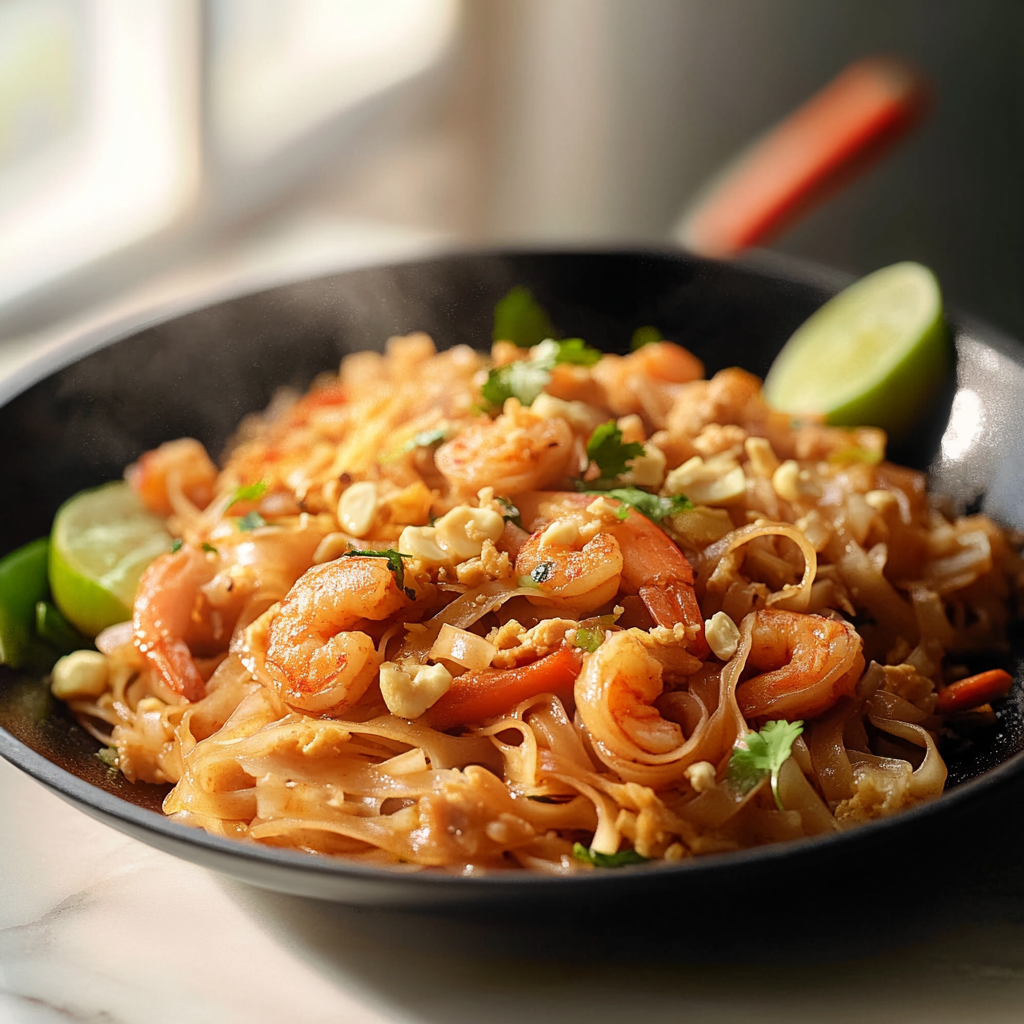
Tips and Tricks
Here are some helpful tips to ensure the best results for your dish:
- Use Fresh Ingredients: Fresh herbs like cilantro can enhance flavor significantly—consider adding them just before serving.
- Don’t Overcook Noodles: Softer noodles are easy to handle but avoid mushiness by soaking instead of boiling them directly.
- Garnish Wisely: Top with crushed peanuts and lime wedges just before serving for added texture and brightness.
Mistakes to avoid
- Skipping the Soaking Step: One common mistake when preparing Pad Thai is not soaking the rice noodles properly. Soaking is crucial as it helps the noodles achieve the right texture. If you skip this step, your noodles may become clumpy or mushy when you stir-fry them. Aim to soak the rice noodles in warm water for at least 30 minutes before cooking. This allows them to soften evenly and absorb flavors during cooking, ensuring a perfect Pad Thai experience.
- Overcooking the Noodles: Overcooking your noodles can ruin your Pad Thai dish. Instead of a delightful chewiness, you’ll end up with an unappetizing mush. Cook the soaked noodles according to package instructions, and remember that they will continue to cook slightly while stir-frying. Keep a close eye on them and remove them from heat as soon as they are al dente. This attention will help maintain their ideal texture.
- Neglecting Ingredient Quality: The quality of ingredients plays a vital role in crafting an authentic Pad Thai. Using subpar ingredients can lead to a lackluster dish. Opt for fresh vegetables, high-quality protein, and authentic sauces like tamarind paste and fish sauce. These elements contribute significantly to the overall flavor profile of your Pad Thai, making it rich and satisfying.
- Forgetting to Balance Flavors: A well-made Pad Thai should have a balance of sweet, salty, sour, and spicy flavors. Many cooks make the mistake of focusing too much on one element while neglecting others. To achieve harmony in your dish, taste as you go and adjust seasoning accordingly. Add lime juice for acidity, sugar for sweetness, and chili flakes for heat to create that signature flavor combination that defines great Pad Thai.
- Not Using Enough Heat: Cooking Pad Thai over low heat can lead to soggy results rather than achieving that smoky flavor associated with traditional street food versions. Use a high heat setting when stir-frying to ensure quick cooking while sealing in flavors. This technique creates that characteristic charred taste that elevates your Pad Thai from average to exceptional.
Serving Suggestions
This Pad Thai is versatile and pairs wonderfully with:
- Fresh Lime Wedges: A squeeze of lime adds a zesty brightness that enhances the flavors of Pad Thai.
- Sriracha Sauce: For those who enjoy a spicy kick, drizzling Sriracha over your dish can elevate it further.
- Crispy Spring Rolls: These make for a delightful side, offering a crunchy texture that complements the soft noodles.
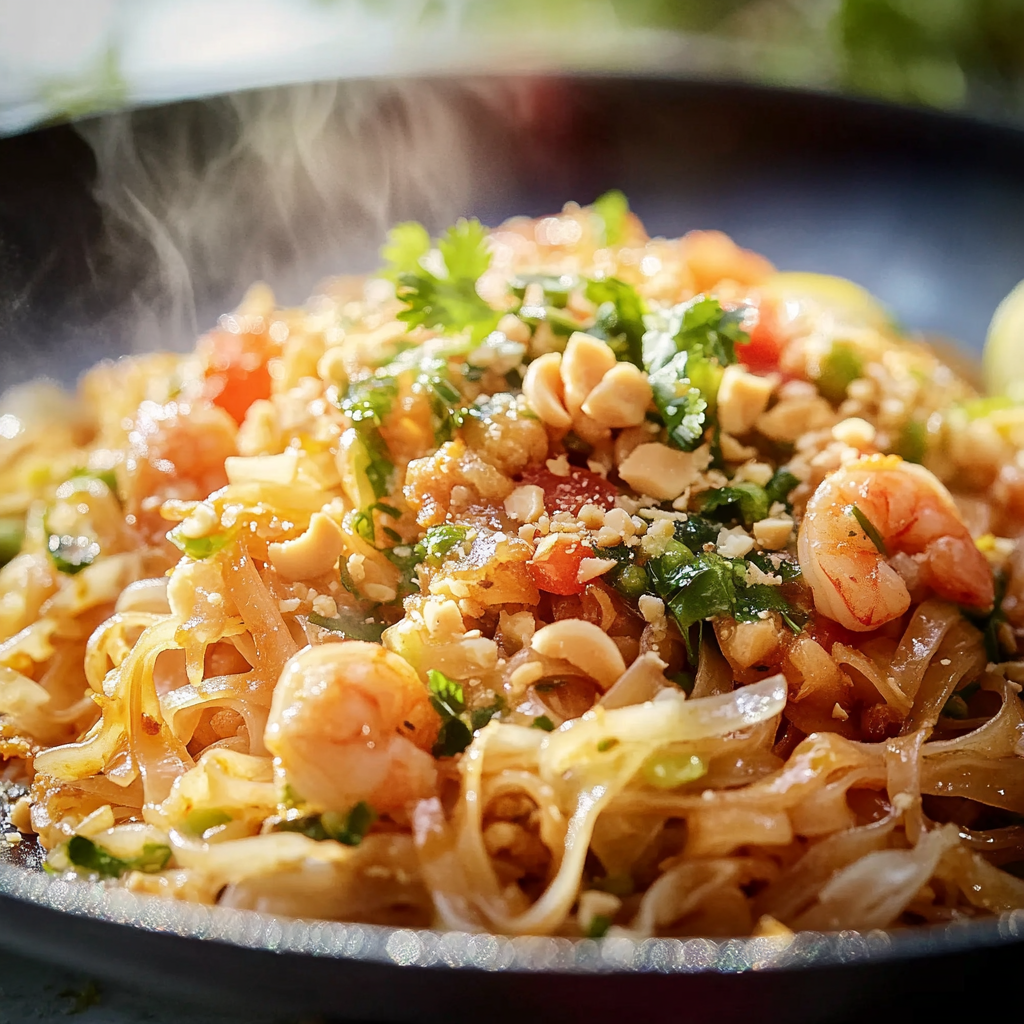
FAQs
What is traditional Pad Thai made of?
Traditional Pad Thai features rice noodles stir-fried with ingredients like shrimp, chicken, or tofu. It also includes eggs, bean sprouts, and green onions. The dish is typically seasoned with tamarind paste, fish sauce, and sugar to create a balance of sweet, salty, and sour flavors. Peanuts are often sprinkled on top for added crunch. This combination of ingredients makes Pad Thai a beloved street food dish in Thailand.
How can I make Pad Thai vegetarian?
To prepare a vegetarian version of Pad Thai, simply substitute shrimp or chicken with tofu or your favorite vegetables. Use soy sauce instead of fish sauce to maintain the umami flavor while keeping it plant-based. Additionally, you can include more vegetables like bell peppers, broccoli, or carrots to enhance the nutritional value. This way, you’ll enjoy the same great taste without compromising your dietary preferences.
Can I make Pad Thai gluten-free?
Yes! To make Pad Thai gluten-free, start by using rice noodles as they are naturally gluten-free. Ensure that any sauces you use, particularly fish sauce and soy sauce, are labeled gluten-free. Many brands offer gluten-free soy sauces which work perfectly in this recipe. By making these adjustments, you can savor delicious Pad Thai without any gluten concerns.
What can I substitute for tamarind paste in Pad Thai?
If you don’t have tamarind paste on hand, an excellent substitute for Pad Thai is a mixture of lime juice and brown sugar. This combination mimics the tangy sweetness of tamarind quite well. You can also use vinegar combined with sugar or even store-bought sweet and sour sauce as an alternative. While these substitutes may alter the flavor slightly, they will still result in a tasty dish.
Conclusion for Pad Thai
In summary, making delicious Pad Thai at home is both simple and rewarding. By following the recipe closely and utilizing fresh ingredients like rice noodles and proteins of your choice—be it shrimp or tofu—you’ll create an authentic taste experience. Don’t forget to customize your dish with serving suggestions like lime wedges or Sriracha for extra flavor. Whether you’re preparing this classic dish for a weeknight dinner or a special occasion, it’s sure to impress your family and friends alike! Enjoy experimenting with different variations to find your perfect version of Pad Thai!
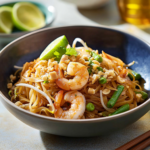
Pad Thai
- Total Time: 30 minutes
- Yield: Serves 4
Description
Pad Thai is a beloved Thai street food that combines the perfect balance of sweet, salty, and tangy flavors in every bite. This quick and easy recipe showcases stir-fried rice noodles tossed with fresh vegetables, your choice of protein—such as tofu or chicken—and roasted peanuts for an added crunch. The signature sauce made with tamarind paste, soy sauce, and brown sugar delivers an authentic taste that rivals your favorite restaurant dish. Perfect for busy weeknights or impressing guests at a dinner party, this Pad Thai recipe is customizable to suit various dietary preferences. Serve it hot with a squeeze of lime and a sprinkle of crushed peanuts to elevate your meal to new heights.
Ingredients
- Flat rice noodles
- Firm tofu or boneless chicken
- Fresh eggs
- Tamarind paste
- Low-sodium soy sauce
- Brown sugar
- Garlic
- Fresh vegetables (e.g., bell peppers, bean sprouts)
- Crushed peanuts
Instructions
- Soak rice noodles in warm water for 20 minutes until softened.
- In a bowl, mix tamarind paste, soy sauce, and brown sugar; set aside.
- In a skillet over medium-high heat, cook cubed tofu or sliced chicken until golden brown; remove from pan.
- Stir-fry garlic and assorted vegetables until tender-crisp.
- Add soaked noodles and proteins to the skillet; pour sauce over and toss gently.
- Create space in the pan for eggs, scramble them quickly, then combine all ingredients.
- Prep Time: 20 minutes
- Cook Time: 10 minutes
- Category: Main
- Method: Stir-frying
- Cuisine: Thai
Nutrition
- Serving Size: 1 plate (350g)
- Calories: 450
- Sugar: 10g
- Sodium: 900mg
- Fat: 18g
- Saturated Fat: 3g
- Unsaturated Fat: 15g
- Trans Fat: 0g
- Carbohydrates: 60g
- Fiber: 3g
- Protein: 15g
- Cholesterol: 150mg

